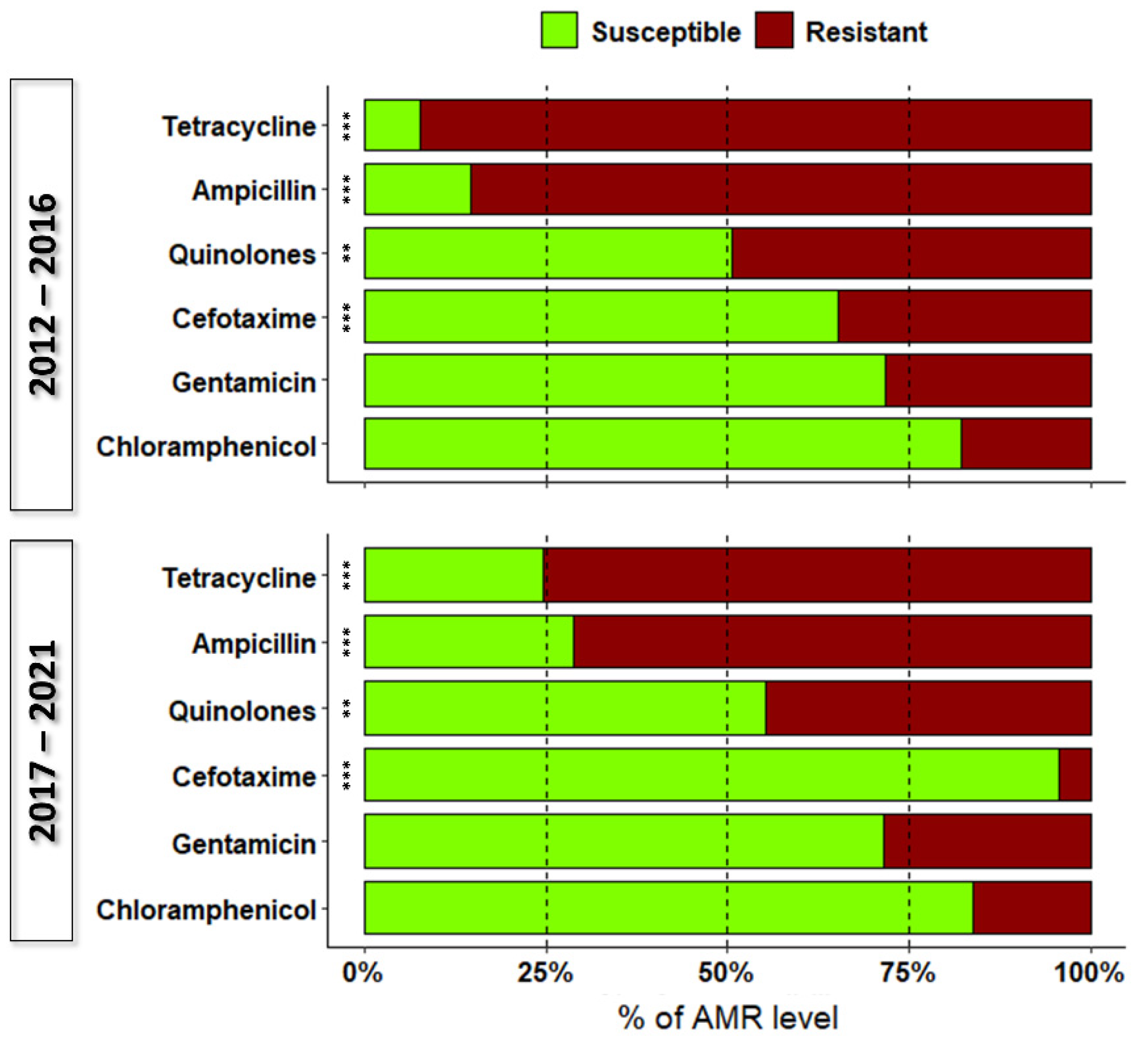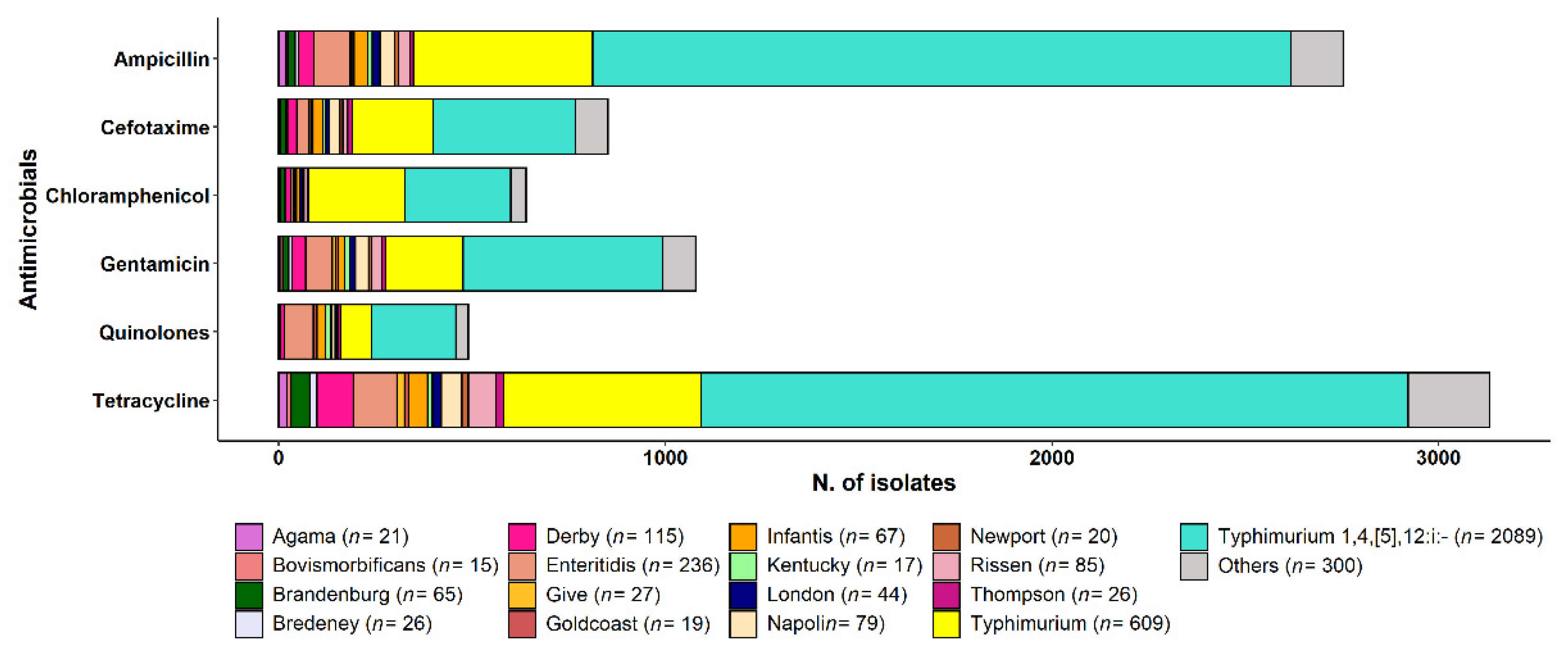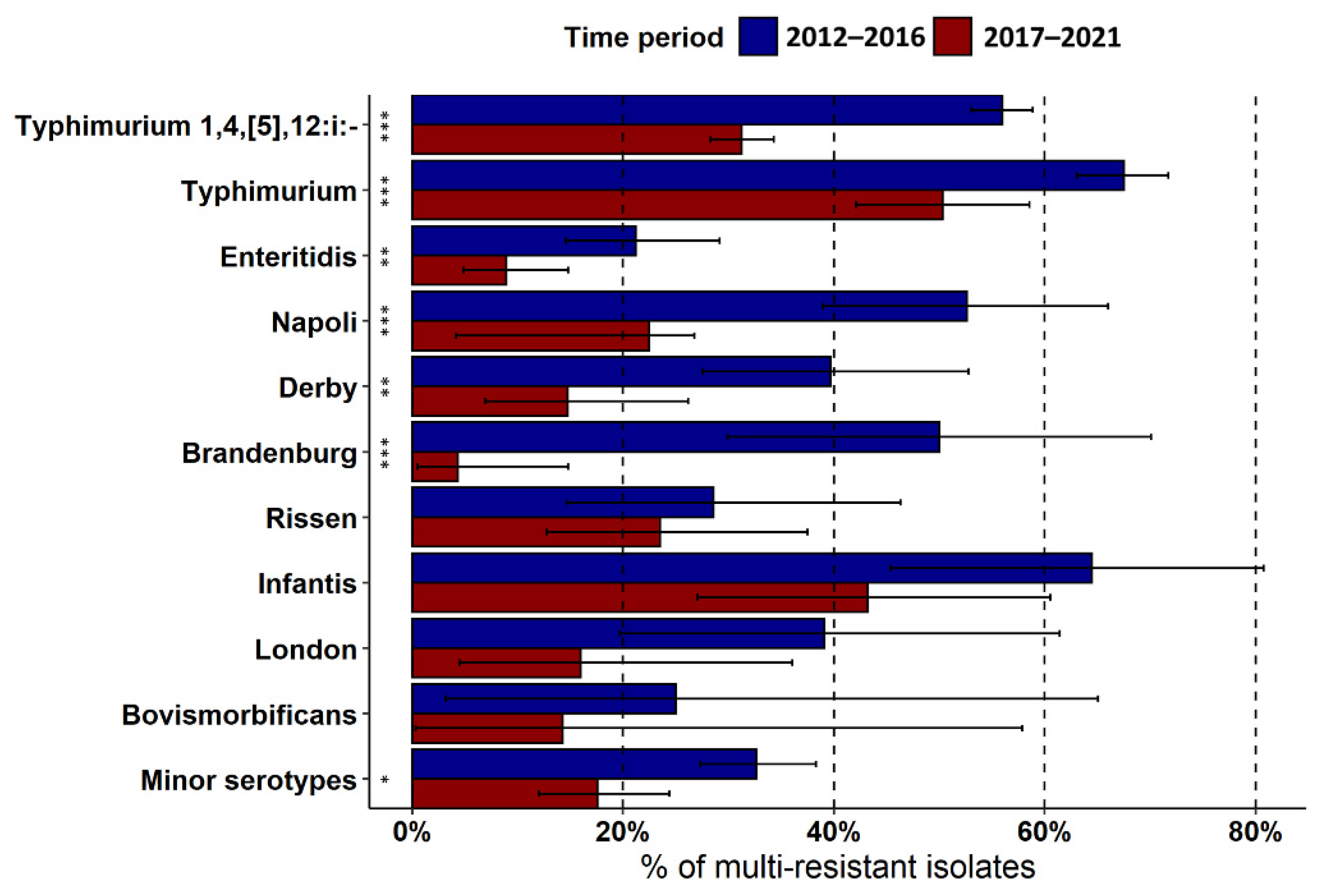Monitoring of Antimicrobial Resistance of Salmonella Serotypes Isolated from Humans in Northwest Italy, 2012–2021
Abstract
:1. Introduction
2. Materials and Methods
2.1. Human Sample Collection and Salmonella Serotyping
2.2. Antimicrobial Susceptibility Testing
2.3. Statistical Analysis
3. Results
3.1. Salmonella Serotyping
3.2. Antimicrobial Resistance
Multidrug Resistance (MDR)
4. Discussion
5. Conclusions
Supplementary Materials
Author Contributions
Funding
Institutional Review Board Statement
Informed Consent Statement
Data Availability Statement
Conflicts of Interest
References
- EFSA and ECDC (European Food Safety Authority and European Centre for Disease Prevention and Control). The European Union One Health 2020 Zoonosis Report. EFSA J. 2021, 19, 6971. [Google Scholar] [CrossRef]
- European Centre for Disease Prevention and Control. Salmonellosis. ECDC Annual Epidemiological Report for 2021; ECDC: Stockholm, Sweden, 2022. Available online: https://www.ecdc.europa.eu/en/publications-data/salmonellosis-annual-epidemiological-report-2021 (accessed on 27 December 2022).
- Gal-Mor, O.; Boyle, E.C.; Grassl, G.A. Same species, different diseases: How and why typhoidal and non-typhoidal Salmonella enterica serovars differ. Front. Microbiol. 2014, 5, 391. [Google Scholar] [CrossRef] [PubMed] [Green Version]
- Butler, T.; Knight, J.; Nath, S.K.; Speelman, P.; Roy, S.K.; Azad, M.A. Typhoid fever complicated by intestinal perforation: A persisting fatal disease requiring surgical management. Rev. Infect. Dis. 1985, 7, 244–256. [Google Scholar] [CrossRef] [PubMed]
- Crump, J.A. Progress in Typhoid Fever Epidemiology. Clin. Infect. Dis. 2019, 68 (Suppl. 1), S4–S9. [Google Scholar] [CrossRef] [Green Version]
- Shinohara, N.K.; Barros, V.B.; Jimenez, S.M.; Machado Ede, C.; Dutra, R.A.; De Lima Filho, J.L. Salmonella spp., important pathogenic agent transmitted through foodstuffs. Ciência Saúde Coletiva 2008, 13, 1675–1683. [Google Scholar] [CrossRef] [Green Version]
- Berger, C.N.; Sodha, S.V.; Shaw, R.K.; Griffin, P.M.; Pink, D.; Hand, P.; Frankel, G. Fresh fruit and vegetables as vehicles for the transmission of human pathogens. Environ. Microbiol. 2010, 12, 2385–2397. [Google Scholar] [CrossRef]
- Grivas, G.; Lagousi, T.; Mandilara, G. Epidemiological Data, Serovar Distribution and Antimicrobial Resistance Patterns of Salmonella Species in Children, Greece 2011–2017: A Retrospective Study. Acta Med. Acad. 2020, 49, 255–264. [Google Scholar] [CrossRef] [PubMed]
- Marchello, C.S.; Fiorino, F.; Pettini, E.; Crump, J.A. Incidence of non-typhoidal Salmonella invasive disease: A systematic review and meta-analysis. J. Infect. 2021, 83, 523–532. [Google Scholar] [CrossRef] [PubMed]
- Akinyemi, K.O.; Ajoseh, S.O.; Fakorede, C.O. A systemic review of literatures on human Salmonella enterica serovars in Nigeria (1999–2018). J. Infect. Dev. Ctries. 2021, 15, 1222–1235. [Google Scholar] [CrossRef]
- Kariuki, S.; Gordon, M.A.; Feasey, N.; Parry, C.M. Antimicrobial resistance and management of invasive Salmonella disease. Vaccine 2015, 33 (Suppl. 3), C21–C29. [Google Scholar] [CrossRef]
- EFSA and ECDC (European Food Safety Authority and European Centre for Disease Prevention and Control). The European Union Summary Report on Antimicrobial Resistance in zoonotic and indicator bacteria from humans, animals and food in 2019/2020. EFSA J. 2022, 20, 7209. [Google Scholar] [CrossRef]
- Eng, S.K.; Pusparajah, P.; Ab Mutalib, N.S.; Ser, H.L.; Chan, K.G.; Lee, L.H. Salmonella: A review on pathogenesis, epidemiology and antibiotic resistance. Front. Life Sci. 2015, 8, 284–293. [Google Scholar] [CrossRef] [Green Version]
- Kauffmann-White and Le Minor. Antigenic formulae of the Salmonella serovars. Bergey’s Man. Syst. Bacteriol. 1984, 1, 429–445. Available online: https://www.pasteur.fr/sites/default/files/veng_0.pdf (accessed on 27 December 2022).
- Matuschek, E.; Brown, D.F.J.; Kahlmeter, G. Development of the EUCAST disk diffusion antimicrobial susceptibility testing method and its implementation in routine microbiology laboratories. Clin. Microbiol. Infect. 2014, 20, O255–O266. [Google Scholar] [CrossRef] [PubMed] [Green Version]
- The European Committee on Antimicrobial Susceptibility Testing (EUCAST). Breakpoint Tables for Interpretation of MICs and Zone Diameters, Version 11.0; European Society of Clinical Microbiology and Infectious Diseases: Växjö, Sweden, 2021; Available online: http://www.eucast.org (accessed on 27 December 2022).
- CLSI Document M100-S22; Performance Standards for Antimicrobial Susceptibility Testing: Twenty-Second Informational Supplement. Clinical and Laboratory Standards Institute: Wayne, PA, USA, 2012.
- CLSI Document M100-S23; Performance Standards for Antimicrobial Susceptibility Testing: Twenty-Third Informational Supplement. Clinical and Laboratory Standards Institute: Wayne, PA, USA, 2014.
- StataCorp LLC. Stata Statistical Software, Release 16; StataCorp LLC: Collage Station, TX, USA, 2019. [Google Scholar]
- Cuzick, J. A Wilcoxon-type test for trend. Stat. Med. 1985, 4, 87–90. [Google Scholar] [CrossRef]
- Breurec, S.; Reynaud, Y.; Thierry, F.; Farra, A.; Costilhes, G.; Weill, F.X.; Le Hello, S. Serotype distribution and antimicrobial resistance of human Salmonella enterica in Bangui, Central African Republic, from 2004 to 2013. PLoS Negl. Trop. Dis. 2019, 13, 7917. [Google Scholar] [CrossRef] [Green Version]
- El-Tayeb, M.; Ibrahim, A.S.S.; Al-Salamah, A.A.; Almaary, K.S.; Elbadawi, Y.B. Prevalence, serotyping and antimicrobials resistance mechanism of Salmonella enterica isolated from clinical and environmental samples in Saudi Arabia. Braz. J. Microbiol. 2017, 48, 499–508. [Google Scholar] [CrossRef]
- Ceyssens, P.J.; Mattheus, W.; Vanhoof, R.; Bertrand, S. Trends in Serotype distribution and Antimicrobial Susceptybility in Salmonella enterica Isolates from Humans in Belgium, 2009 to 2013. Antimicrob. Agents Chemother. 2015, 59, 544–552. [Google Scholar] [CrossRef] [Green Version]
- Mastrorilli, E.; Pietrucci, D.; Barco, L.; Ammendola, S.; Petrin, S.; Longo, A.; Mantovani, C.; Battistoni, A.; Ricci, A.; Desideri, A.; et al. A Comparative Genomic Analysis Provides Novel Insights Into the Ecological Success of the Monophasic Salmonella Serovar 4,[5],12:i:-. Front. Microbiol. 2018, 17, 715. [Google Scholar] [CrossRef]
- Mughini-Gras, L.; Pijnacker, R.; Duijster, J.; Heck, M.; Wit, B.; Veldman, K.; Franz, E. Changing epidemiology of invasive non-typhoid Salmonella infection. Clin. Microbiol. Infect. 2020, 26, 941. [Google Scholar] [CrossRef]
- Galanakis, E.; Bitsori, M.; Maraki, S.; Giannakopoulou, C.; Samonis, G.; Tselentis, Y. Invasive non-typhoidal salmonellosis in immunocompetent infants and children. Int. J. Infect. Dis. 2007, 11, 36–39. [Google Scholar] [CrossRef] [PubMed]
- Jones, T.F.; Ingram, L.A.; Cieslak, P.R.; Vugia, D.J.; Tobin-D′Angelo, M.; Hurd, S.; Medus, C.; Cronquist, A.; Angulo, F.J. Salmonellosis outcomes differ substantially by serotype. J. Infect. Dis. 2008, 198, 109–114. [Google Scholar] [CrossRef] [PubMed]
- Oliveira dos Reis, R.; Cecconi, M.C.; Timm, L.; Neves Souza, M.; Ikuta, N.; Wolf, J.M.; Lunge, W.R. Salmonella isolates from urine cultures: Serotypes and antimicrobial resistance in hospital settings. Braz. J. Microbiol. 2019, 50, 445–448. [Google Scholar] [CrossRef] [PubMed]
- Ramos, J.M.; Aguado, J.M.; García-Corbeira, P.; Alés, J.M.; Soriano, F. Clinical spectrum of urinary tract infections due on nontyphoidal Salmonella species. Clin. Infect. Dis. 1996, 23, 388–390. [Google Scholar] [CrossRef]
- Sivapalasingam, S.; Hoekstra, R.M.; McQuiston, J.R.; Fields, P.I.; Tauxe, R.V. Salmonella bacteriuria: An increasing entity in elderly women in the United States. Epidemiol. Infect. 2004, 132, 897–902. [Google Scholar] [CrossRef]
- Allerberger, F.J.; Dierich, M.P.; Ebner, A.; Keating, M.R.; Steckelberg, J.M.; Yu, P.K.; Anhalt, J.P. Urinary tract infection caused by nontyphoidal Salmonella: Report of 30 cases. Urol. Int. 1992, 48, 395–400. [Google Scholar] [CrossRef]
- Peruzy, M.F.; Capuano, F.; Proroga, Y.T.R.; Cristiano, D.; Carullo, M.R.; Murru, N. Antimicrobial Susceptibility Testing for Salmonella Serovars Isolated from Food Samples: Five-Year Monitoring (2015–2019). Antibiotics 2020, 9, 365. [Google Scholar] [CrossRef]
- Burke, L.; Hopkins, K.L.; Meunier, D.; De Pinna, E.; Fitzgerald-Hughes, D.; Humphreys, H.; Woodford, N. Resistance to third-generation cephalosporins in human non-typhoidal Salmonella enterica isolates from England and Wales, 2010–2012. J. Antimicrob. Chemother. 2014, 69, 977–981. [Google Scholar] [CrossRef] [Green Version]
- Regulation, H. Council Regulation (EEC) No 2377/90 of 26 June 1990 laying down a Community procedure for the establishment of maximum residue limits of veterinary medicinal products in foodstuffs of animal origin. Off. JL 1990, 224, 1–8. [Google Scholar]
- Callens, B.; Cargnel, M.; Sarrazin, S.; Dewulf, J.; Hoet, B.; Vermeersch, K.; Wattiau, P.; Welby, S. Associations between a decreased veterinary antimicrobial use and resistance in commensal Escherichia coli from Belgian livestock species (2011–2015). Prev. Vet. Med. 2018, 157, 50–58. [Google Scholar] [CrossRef] [Green Version]
- European Centre for Disease Prevention and Control (ECDC); European Food Safety Authority (EFSA); European Medicines Agency (EMA). Third joint inter-agency report on integrated analysis of consumption of antimicrobial agents and occurrence of antimicrobial resistance in bacteria from humans and food-producing animals in the EU/EEA—JIACRA III 2016–2018. EFSA J. 2021, 19, 6712. [Google Scholar] [CrossRef]
- Proroga, Y.T.R.; Capuano, F.; Carullo, M.R.; La Tela, I.; Capparelli, R.; Barco, L.; Pasquale, V. Occurrence and antimicrobial resistance of Salmonella strains from food of animal origin in southern Italy. Folia Microbiol. 2016, 61, 21–27. [Google Scholar] [CrossRef] [PubMed]





| Serotype | No. Isolates (n = 4814) | Prevalence (95% CI) |
|---|---|---|
| Typhimurium 1,4,[5],12:i:- | 2188 | 45.5 (44.0–46.9) |
| Typhimurium | 666 | 13.8 (12.9–14.8) |
| Enteritidis | 453 | 9.4 (8.6–10.3) |
| Napoli | 172 | 3.6 (3.1–4.1) |
| Derby | 164 | 3.4 (2.9–4.0) |
| Brandenburg | 129 | 2.7 (2.2–3.2) |
| Rissen | 97 | 2.0 (1.6–2.5) |
| Infantis | 84 | 1.7 (1.4–2.2) |
| London | 68 | 1.4 (1.1–1.8) |
| Bovismorbificans | 44 | 0.9 (0.7–1.2) |
| Minor serotypes | 749 | 15.6 (14.5–16.6) |
Disclaimer/Publisher’s Note: The statements, opinions and data contained in all publications are solely those of the individual author(s) and contributor(s) and not of MDPI and/or the editor(s). MDPI and/or the editor(s) disclaim responsibility for any injury to people or property resulting from any ideas, methods, instructions or products referred to in the content. |
© 2023 by the authors. Licensee MDPI, Basel, Switzerland. This article is an open access article distributed under the terms and conditions of the Creative Commons Attribution (CC BY) license (https://creativecommons.org/licenses/by/4.0/).
Share and Cite
Pitti, M.; Garcia-Vozmediano, A.; Tramuta, C.; CeRTiS Clinical Laboratories Group; Maurella, C.; Decastelli, L. Monitoring of Antimicrobial Resistance of Salmonella Serotypes Isolated from Humans in Northwest Italy, 2012–2021. Pathogens 2023, 12, 89. https://doi.org/10.3390/pathogens12010089
Pitti M, Garcia-Vozmediano A, Tramuta C, CeRTiS Clinical Laboratories Group, Maurella C, Decastelli L. Monitoring of Antimicrobial Resistance of Salmonella Serotypes Isolated from Humans in Northwest Italy, 2012–2021. Pathogens. 2023; 12(1):89. https://doi.org/10.3390/pathogens12010089
Chicago/Turabian StylePitti, Monica, Aitor Garcia-Vozmediano, Clara Tramuta, CeRTiS Clinical Laboratories Group, Cristiana Maurella, and Lucia Decastelli. 2023. "Monitoring of Antimicrobial Resistance of Salmonella Serotypes Isolated from Humans in Northwest Italy, 2012–2021" Pathogens 12, no. 1: 89. https://doi.org/10.3390/pathogens12010089





